Similar Posts
Anna Pokrovsky Gouriev is a professional iconographer working in the United States. Originally from Russia, she is the daughter of Ksenia Pokrovsky who was one of the instrumental voices for the rediscovery of traditional iconography in the 20th century. Jonathan Pageau teaches with her at the Hexaemeron School of Ecclesial Arts, and it is in that context that his discussion with Anna was recorded.
Her website can be found here: http://www.izograph.com/
JONATHAN PAGEAU: Your mother, Ksenia Pokrovsy, played a pivotal role in this rediscovery of the icon that happened in the later 20th century. You moved to the US in your early twenties, but while you were in Russia under the communist government, there was still low-level hostility towards this type of art. Please, tell me a little bit about how your mother went about practicing iconography and teaching iconography?
ANNA GOURIEV: Well, she was just working all the time, and she had students come and go and live with us for a while, a month, a couple months, or a year. She was just working and there was some concern, but it was what I now call a “vegetarian time”. The regime was vegetarian, I mean, they were not eating people alive anymore. It was a low-level hostility like you said.
PAGEAU: And how did she learn to paint icons?
GOURIEV: Well, she started in 1970, and that’s the year I was born, so I know some bits and pieces. I never asked her, really. It was so much a part of my life, and I think the story is well known because she told it herself many times. Father Alexander Men told her she should try painting icons, and he was doing it himself. He gave her all of his paints and drawings, and I still have a little drawing of the crucifixion that he gave her.
Then, she just started working. I’m sure it was gradual. I found one of her very early icons that she made, and it’s an icon of St. Dimitri. That was my brother’s name, and I’m sure that she made it for him. The icon is very old now, but I was amazed of how clear the Olifa is. You know how icons usually darken with time because of the olifa, the oil varnish? It could have been completely black by now, but it’s so fresh like it was done yesterday. I was very surprised. When I asked her what kind of Olifa she used, you know, and where she got it … you can’t get those answers (laughs).
PAGEAU: And so, basically, you grew up in a world of icons?
GOURIEV: I guess, I mean, it was so natural, l never thought of it, but we had a very enclosed life. We had our own world. Though then we would have to go out to school…that was a disaster. But besides that, we had we had very little contact with the Soviet reality. My mother was not working outside of the house, and my father worked at home pretty much all the time. And we had friends, hundreds of them, and we had the Church. It was like a different planet.
PAGEAU: When did you learn to draw? When did you start to make images?
GOURIEV: I can’t really tell you because I remember I was painting endless crucifixions when I was five or six, but I can’t remember before that, so maybe earlier. I wrote my first icon when I was eight. I still have it, and it’s a little, teeny tiny icon of St. Tatiana. My mother must have helped me a lot because I couldn’t have done it. I know that.
My grandmother passed away in ‘78 and her name was Tatiana, I remember I made it for her. After that first icon, it was on and off, though my mother never pushed me. She never raised me as an iconographer or as her follower. I was free to do whatever I wanted to do.
PAGEAU: So, when did you start making icons more seriously? I imagine at some point you started helping your mother or getting involved in the workshop?
GOURIEV: I came back to it later. Because I went to art school, I was not doing any iconography. And then I got married. I had my kids. When they were a little older, I started helping her.
PAGEAU: Before coming to America, or after?
GOURIEV: I helped her before, on and off when she had big commissions, I remember we went to Kazan one time to help someone out and spent a couple of weeks there working, but there was no point when I thought, oh, now I’m going to start seriously working. It was just whenever you can, no commitments… It’s hard to explain.
PAGEAU: Sure, it seems like it was so much a part of your life, it was the background of you growing up.
GOURIEV: My mom told me that once, when I was 17 or 16, I said that I would never, ever be painting iconography. I don’t remember that, but it must have been true.
PAGEAU: Well, that is the right age to say that! (laughs) At that age you want to stand apart.
GOURIEV: I guess I was in art school, and maybe I wanted to do something different. But it was never implied that this is what I should be doing.
PAGEAU: And then what prompted your family coming to the United States and what were the circumstances around that?
GOURIEV: Well, I know that my it was my father’s idea. He wanted to leave, and my mom didn’t want to. It was in 1990, and things were not looking bright in Russia. My father was sure that it wasn’t going to end well, you know, the Perestroika was not going to end well. He thought some kind of dictatorship was unavoidable. That’s why he wanted to leave. (Editor’s note: 1990 is also when Fr. Alexander Men was murdered.)
PAGEAU: And so you came to America. What was it like moving from Russia, where even though it was a Soviet state, iconography was still at least part of the history of the church? Those who were still attached to the church wanted icons, needed icons to a certain extent. How was it coming to America where Orthodoxy was so new? Coming to a nation where Orthodoxy was still developing or finding its way?, Did your family start working in the world of iconography right away or did it take some time?
GOURIEV: My mom was doing commissions for churches in America before we came, so she was known somewhat, and after she came it just developed, you know? There was a great interest.
PAGEAU: …because there were very few iconographers in the United States at the time?
GOURIEV: Right, so she became well known quickly and there were articles in newspapers and all that kind of stuff. She had a lot of commissions pretty much right away.
PAGEAU: And did you start working with her or did it take some time before that happened?
GOURIEV: I had my first child pretty quickly, so I was busy, but that was about the time we met Mary Lowell (founder of Hexaemeron School for the Ecclesial Arts https://www.hexaemeron.org). When we met Mary, my mom was working for St. Andrews on the iconostasis, and I was helping with that. But still, I was only helping on and off, whenever I could. My daughter was my full-time job (laughs)
PAGEAU: That’s for sure. But today, I imagine iconography is pretty much full time at this point…
GOURIEV: Yeah, that’s right. Yeah. That’s all I can do.
PAGEAU: What do you mean?
GOURIEV: I don’t have any other profession. I don’t have any anything else I could be doing because I don’t really know how to do anything else.
PAGEAU: Would you want to do something else?
GOURIEV: Probably not (laughs). Most definitely not. I can weave, I can do tapestries. That’s what I was trained to do in art school, Oriental rugs and tapestry. I can weave, I can design a tapestry and weave it. And I’ve done some of that. I’m still doing some of that sometimes, but it’s still art. The other day I was thinking that I probably would like to know more chemistry than I do.
PAGEAU: Well, your mother Xenia, wasn’t she was a chemist?
GOURIEV: She was a biophysicist, but that’s a lot of chemistry.
PAGEAU: It’s interesting because it seems Xenia was a scientist who ended up making icons, but you seem to be someone who had been attracted to art your whole life.
GOURIEV: Yeah, I did really poorly in school (laughs)… No, the only subject where I did OK was English. But the rest of it, especially science and physics, I could never understand it. So, I barely made it through school.
PAGEAU: So now tell me, what does a day’s work look like for you?
GOURIEV: Sometimes I’m working on just one thing, sometimes it’s many things. It depends on what I’ve got, what conditions I have, and what work I’ve got to do. There is a lot of drying and curing time, so you can put it off to the side and work on something else. But I work nights mostly, and we recently moved so I have a new workspace that I need to get used to and it’s going to be very different from what it was because it’s completely different setting. So, I don’t really know how it’s going to be, what is going to be like.
I hope it works out. The new workshop is in a barn, so in the middle of the night I have to go home and there are coyotes in the woods, you know, so I think I’m going to get myself a BB gun, because I’m scared (laughs). I hear them at 2:00 or 3:00 in the morning and I have to walk past. It’s not far, I just have to cross the backyard, but they are scary!
PAGEAU: Oh Yeah, wow! Do you work alone?
GOURIEV: I work alone. I cannot work with anyone. I have to be alone.
PAGEAU: What about when you were working with your mother? Did you work on the same icons or did you each have your own projects?
GOURIEV: Sometimes we worked on the same icon. On the big projects we would be working together on the same icons. For little commissions I came up with a rule that we followed: if it was her commission that I was helping with, she could correct or do anything with it, whatever she wanted. But if it was my commission, then she could only suggest things and I did not have to accept it or fix things that she would point out if I thought it was OK. So, you know, it worked.
We had fights sometimes. But on her commissions she was answerable, she responsible for them. I could not argue. Whatever she commented on, I had to fix it without arguing.
PAGEAU: One of the things that characterizes your icons and I think Xenia’s icons as well is what I could call it a kind of sobriety. It seems there’s a desire to create something that is simple, deliberately simple. Not something that is too ornate. Sobriety is a good word because simplicity can sound negative, but sobriety implies that it is almost a form of asceticism.
GOURIEV: Ah, like the word “sober”.
PAGEAU: Yes, sober, right. You are pulling the icon into its most basic elements, I would say. I may be completely off, but when I look at your icons that is something that I get from them.
GOURIEV: We’re not doing it purposefully. We’re just following a certain school that we accepted, and it’s a 16th century Moscow school. That’s all. There’s nothing “special”, we’re not really creating anything, we’re just following the old icons from that period.
PAGEAU: But even in the 16th century, some of those images will have some pretty intense aspects in the Russian tradition. Aspects like, you know, wide shoulders and massive foreheads, etc. There’s a stylization which, even in the 16th century, is starting to be somewhat extreme. Master Dionysius, for example, coming after Rublev right at the beginning of the 16th century. His figures are very long and stylized, you know.
GOURIEV: Yes. Dionysius is really a different school. We did not follow that. Rublev was too great, really, too great to try to be like him. It just won’t look natural to copy Rublev; it just looks like a caricature. You can’t copy Rublev’s work because it’s just too original. He was the only one, and there’s nobody like him, nobody.
Dionysius did not follow him. He went completely off into his own faith, his own vision.
He created something that is more vulnerable? Dionysius studied with Rublev, but he did not follow him. He went completely off his own faith into his own vision and. His own style.
PAGEAU: Do you feel like Rublev’s style is closer to what you do?
GOURIEV: Yes, you can say that. We’re not trying to make it simpler. We’re not trying to do anything (laughs). I mean, I just do what I do and I’m not trying to be anyone. I don’t have any ideas, any goals. It’s intuitive.
PAGEAU: So what is it, for example, that you would fight about in terms of working on a commission with Xenia? Would you fight about stylistic decisions, or color or composition?
GOURIEV: Usually it would be anatomical mistakes. That’s the only thing that my mom would say, is that it doesn’t look right. Then I would say it looks all right to me.
PAGEAU: And so if you’re working on commission… like I know that last year you finished a big image of the icon of the last judgment… When you are making the figures, how much of it is you using patterns that already existed, and how much of it will you will freehand draw in terms of a massive icon like that?
GOURIEV: I would draw none. I mean, I have to draw some figures, I have to draw all of them, but I’m following a certain prototype. I did not make anything up.
PAGEAU: Wait? So do you find a pre-existing pattern for each figure?
GOURIEV: Yeah, I do. I do, and I’m just trying to think, what would I want to draw out that I couldn’t find in pre-existing prototype?
PAGEAU: Well, sometimes it’s a question of space, right? You have to adjust your image to a space that’s different.
GOURIEV: There is nothing I can adjust. There are many icons of The Last Judgment, and some of them are extremely complicated. It has all already been worked out in the tradition. I don’t really need to solve any more space issues, except for how many teirs of saints I can fit in, and details like that. Or maybe I would have to decide what figures to include, and usually there are more than I can include, so I’m never short. There is never a space I don’t know how to deal with because it’s all been solved before me by previous iconographers.
PAGEAU: What are you working on now?
GOURIEV: Oh, I’m working on a few icons for an iconostasis in Atlanta, Georgia, and then I’m working for the church in Salem, Massachusetts, where the last judgment is. They want more icons on the walls, but I haven’t started them yet. So, I have a few commissions. That Salem project is major.
PAGEAU: when you’re working on the wall icons, what type of medium are you using?
GOURIEV: Acrylics, acrylic on canvas.
PAGEAU: And you make them in your workshop?
GOURIEV: Yes. I have a big wall and I nail the canvas to it. Then I usually have somebody install it, because there are large pieces. I install them too, but others do a better job and they’re better at it than I am. …and then if anything goes wrong, if the icons come off, I’m not responsible (laughs).
PAGEAU: So you’ve been you’ve been teaching now for how many years?
GOURIEV: About 15 years.
PAGEAU: So since you arrived in America from Russia, have you seen a change in the world of iconography in America? Have you seen a difference between the time you arrived and now?
GOURIEV: Yeah, of course, there’s a very big difference. You know, there are many iconographers now. And there is a very big difference in Russia now, too. There are now many wonderful iconographers in Russia. There are more teachers. Well, there’s a very big change and some of it is great and amazing and some of it is really bad.
PAGEAU: So now I must ask you, what is great and what is bad about the change?
GOURIEV: Well, there’s a far more horrible icons out there these days, but there are also a lot of very good teachers and good iconographers working full time. There are more good iconographers in Russia than here, and people are more careful with it, more intentional. Here in America anybody thinks they can do icons.
PAGEAU: Here we have more amateurs?
GOURIEV: Exactly. In Russia amateurs just wouldn’t go after it. They would be more humble. That’s the difference in how they treat the art of iconography. However, the other extreme is thinking that only very special people can paint. So it’s always a mixture of good and bad. And you just take your pick. But it’s very human and it’s very common.
PAGEAU: That’s for sure. And do you think there will be a day when you’ll want to work with someone again, or do you just want to work alone from now on?
GOURIEV: You mean like my mom?
PAGEAU: You could have someone working with you, a student, and now you could criticize their icons (laughs).
GOURIEV: That would be dangerous (laughs). I don’t know. We’ll see. We don’t know what’s going to happen, and whatever is supposed to happen happens. I’ll deal with it then, but I like being alone the most.
My mom loved to teach and my mom loved people. She was very interested in people. She was drawing people together, and people were attracted and because she was so giving and generous with what she knew. That was part of her calling, and I guess I don’t need to do that.
PAGEAU: Sure. You can just work.
GOURIEV: Exactly. My mom was very interested in people, and she could talk to anyone, from a physicist to a drunkard in our village. She would find them and she would have an interesting conversation. And if it was something where she didn’t know anything about the subject, she would want to know and find out everything there was to know about it. I’m not like that. She loved to meet people and to teach. She had a system on how to teach that we use still.
PAGEAU: Would you prefer being in the workshop?
GOURIEV: I prefer working. I don’t think I could teach all the time, though It’s very enjoyable and nice to be with people once in awhile (laughs).
PAGEAU: Once in a while, once a year (laughs).
GOURIEV: Well, now I feel bad. I don’t want it to sound like I don’t like people, I do.
PAGEAU: No, it doesn’t sound like that. It sounds like you’re someone who likes to work on icons. You like to get out once in awhile and see people but you’re not…
GOURIEV: I’m not very outgoing. I’m not a very extroverted person. But the Worskhops I give have been a school for me, and I am very grateful to all the people who come, because I think I learn as much as they do, even times a 100 or times 1000. They really teach me a lot. They ask questions, and you see the mistakes other people make, you learn a lot, but you probably have that too, teaching?
PAGEAU: Yes, I noticed that when I am teaching something, it is forcing me to understand what I am doing better. And as I am trying to figure out how to explain it, I find ways of doing them I had not thought about. And fixing mistakes is great, it is so helpful. So what about your daughter? Is she interested in painting?
GOURIEV: No, no, I have three daughters, three daughters, and not one of them is interested. One is a nurse, and the other two really like animals, so they will probably do something like that. They painted a few icons when they were little. They found it interesting, but it isn’t going to be what they decide to do which is fine.
PAGEAU: Is there something that you haven’t yet made, like an icon that you haven’t yet painted, that you hope that you can make one day?
GOURIEV: Yeah, of course. There are very many icons that have never painted.
PAGEAU: When I heard you did the last judgement, I was very jealous because I wish I could paint that. So, what if you could chose any icon to get a commission for what would it be?
GOURIEV: I need to think. There’s an icon I’d like to do, but I don’t know what it is called in English. But it’s an icon of Christ and the Theotokos. He’s off the cross and the cross is behind Him and She’s holding Him.
PAGEAU: It’s kind of like the moment after the descent of the cross?
GOURIEV: But it’s not the full composition. It’s just Her holding Her son with the cross behind Him.
PAGEAU: It’s a very powerful image.
GOURIEV: I like to do this in one day, but I don’t need it to be commissioned. I could just do it.
PAGEAU: Right, you could just do it because you have a lot of time (laughs).
GOURIEV: No, but you can always find time to do something you really want to do, and when we feel like “oh, we don’t have time” it’s actually an excuse. We do have time. Well, I do. I know I waste a lot of time doing things I shouldn’t be doing. Like watching films. I don’t like TV but I appreciate cinematography, good films. I could stop doing that as much.
PAGEAU: The iconographer Marek Czarnecki once described your icons saying: “Anna’s icons are like drinking a crisp, clean glass of water. It’s refreshing.” I think that’s what I was trying to get to when describing your work: there is a kind of humility or simple restraint. It’s obvious you’re someone who clearly knows what you’re doing, but you don’t want to show off about it. So, when one looks at the image, one senses that every stroke is right. There isn’t a desire to impress with some virtuosity. Does that make sense?
GOURIEV: Yeah, it does. I think the only thing I can explain it is that I know my boundaries. I’m only a tool, I’m nobody. I’m God’s tool, and that is all any iconographer is. We’re not putting ourselves into it, we just have to remember that we’re just tools that God is using to convey His Word. That’s all, and I guess it helps you to stay sober. I try to remember that it’s not about me, it’s not about my talents, it’s not about my gifts. I’m only a conductor.
This is what my mom always used to say. I heard her saying that, I heard her telling students that, I heard it a lot. She would explain to them that “you are not here to express yourself. You have to forget about yourself. Go in, and just try to convey the Word beautifully and correctly.” That’s all we can hope for, all we can to do.
PAGEAU: I think it’s a great way to finish our interview. Thank you.
(The interview was transcribed by Richmond Hahn.)

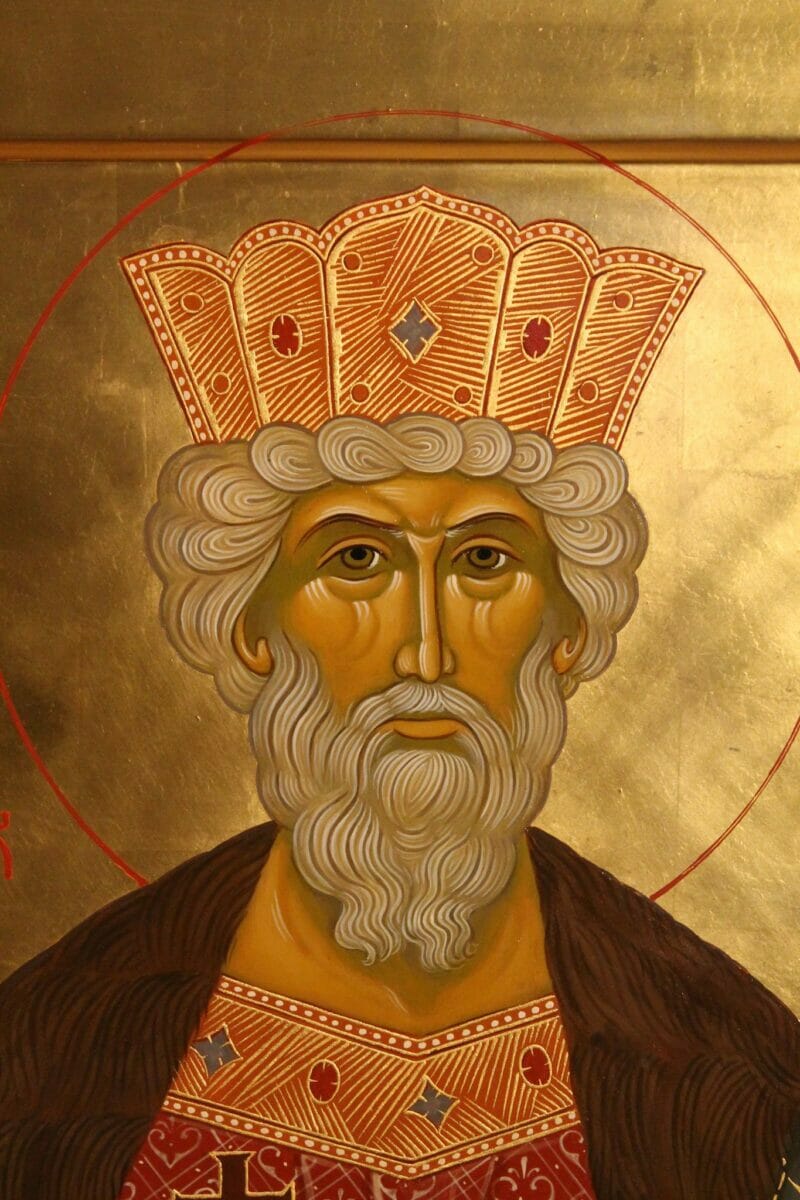
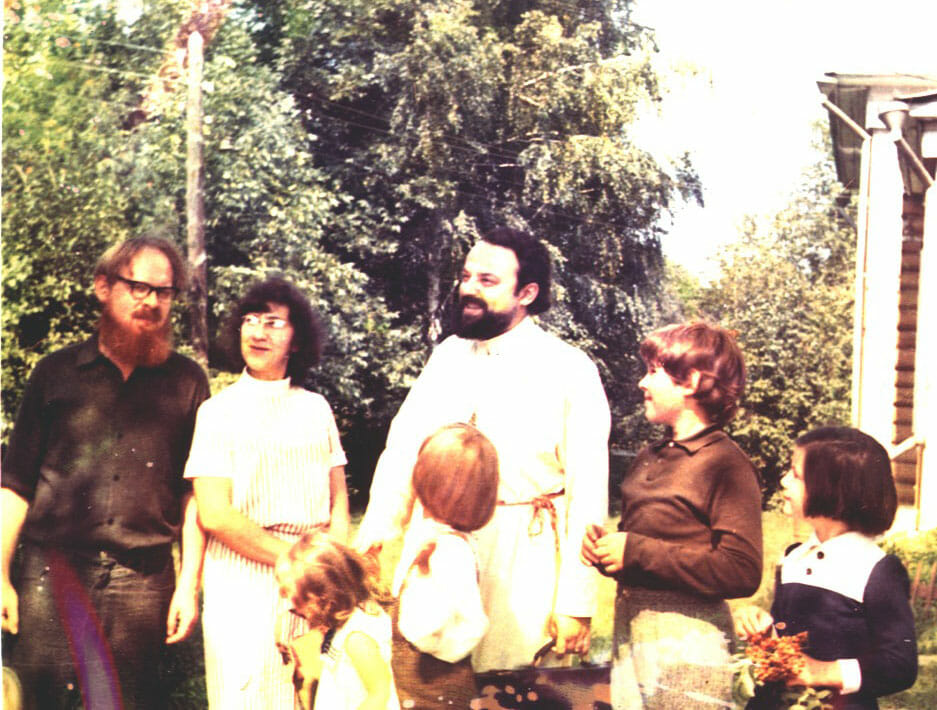
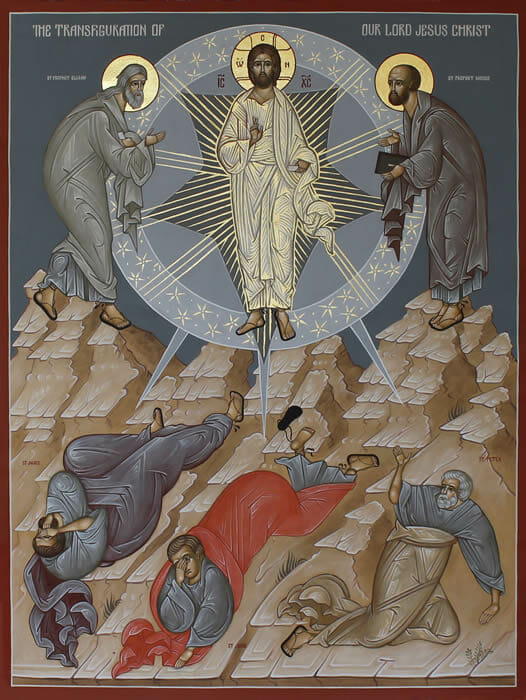
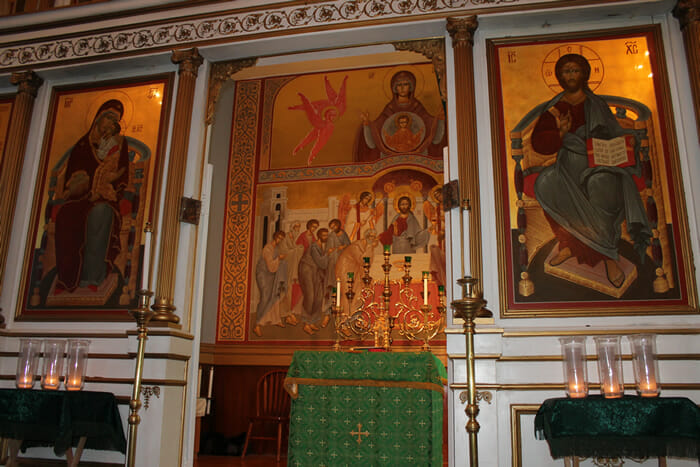
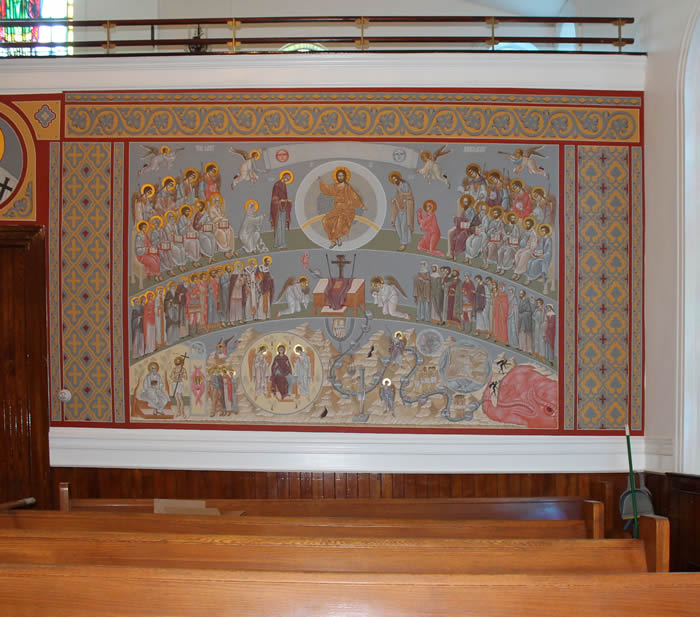
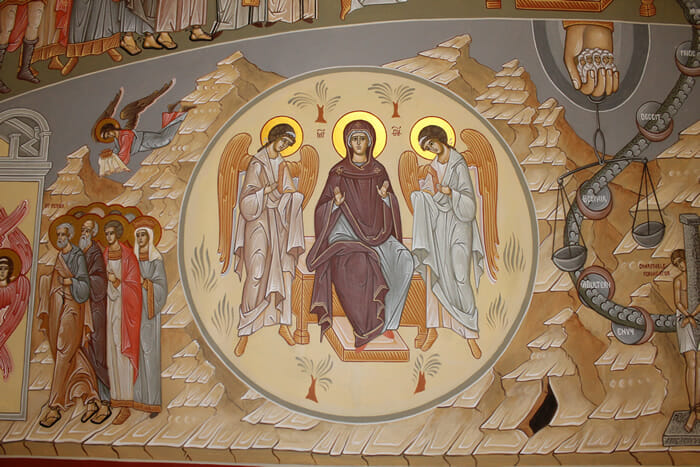

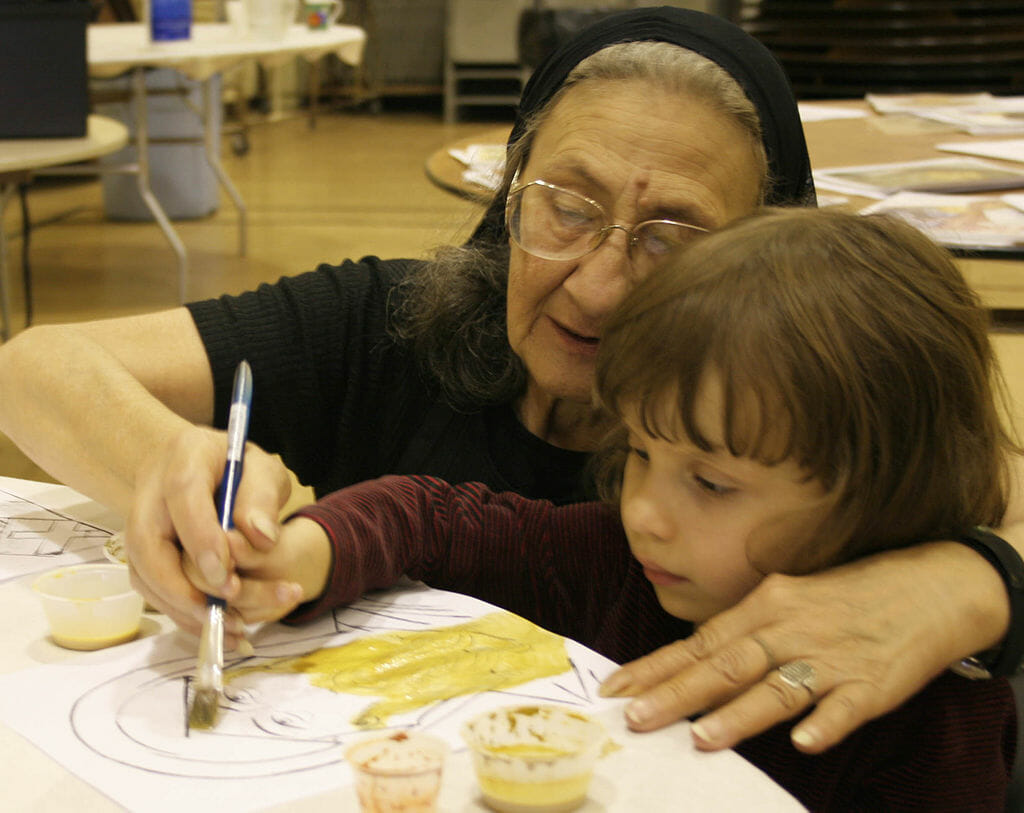

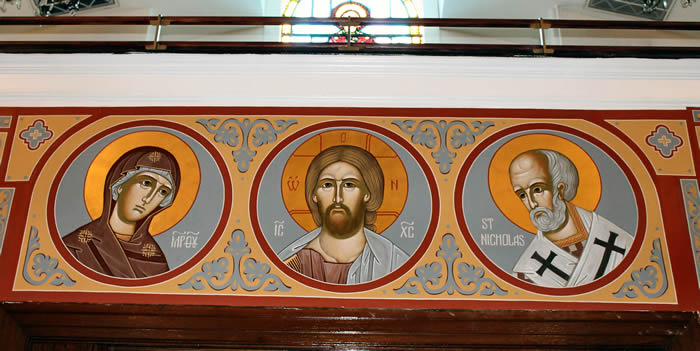
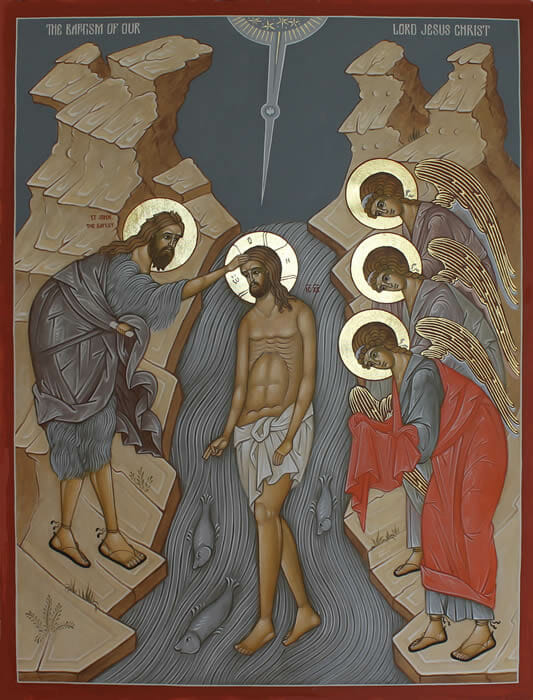
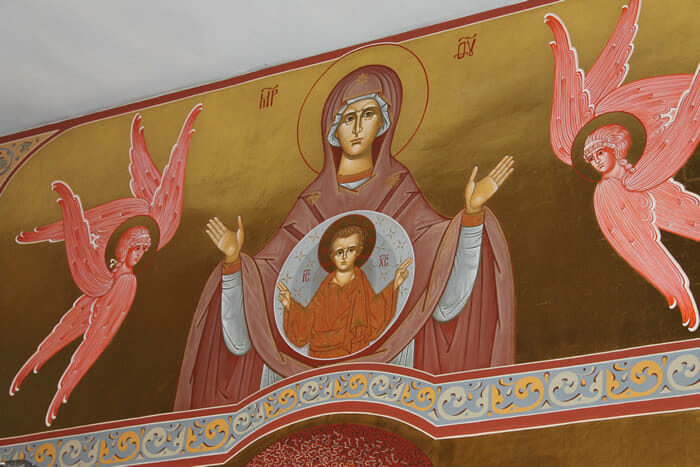
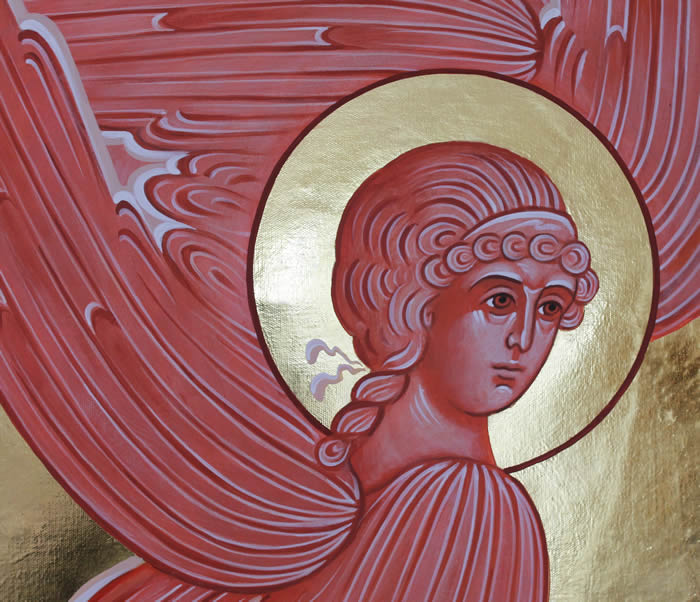
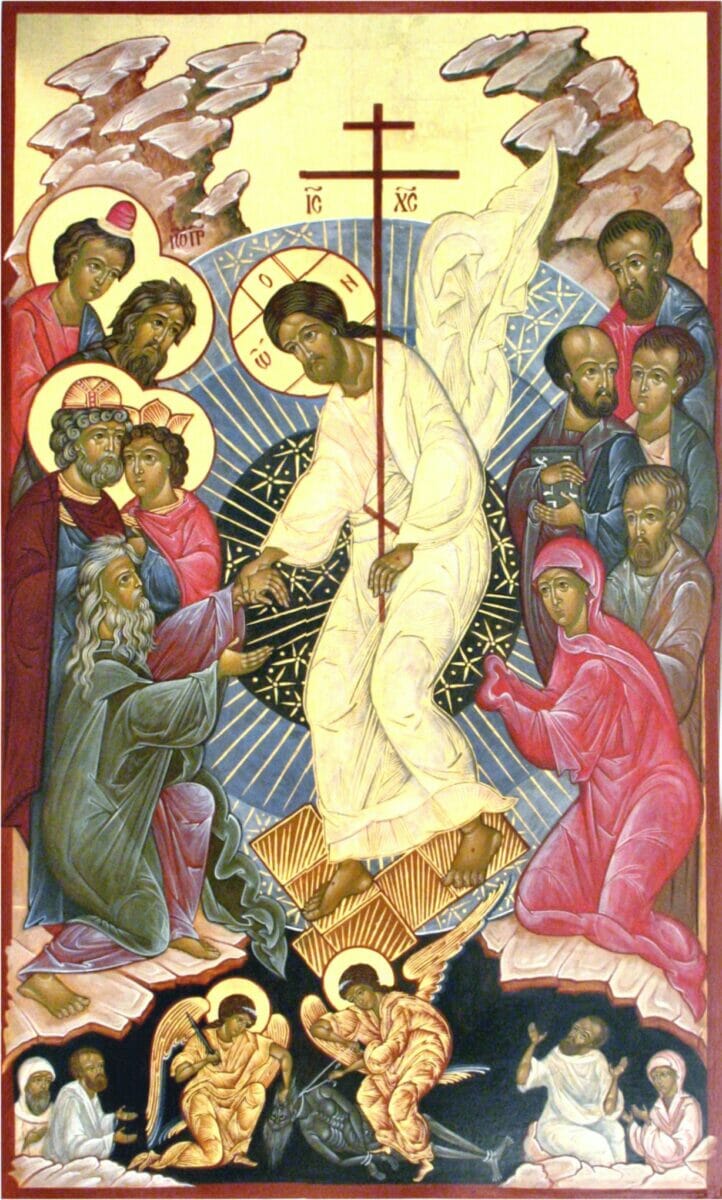
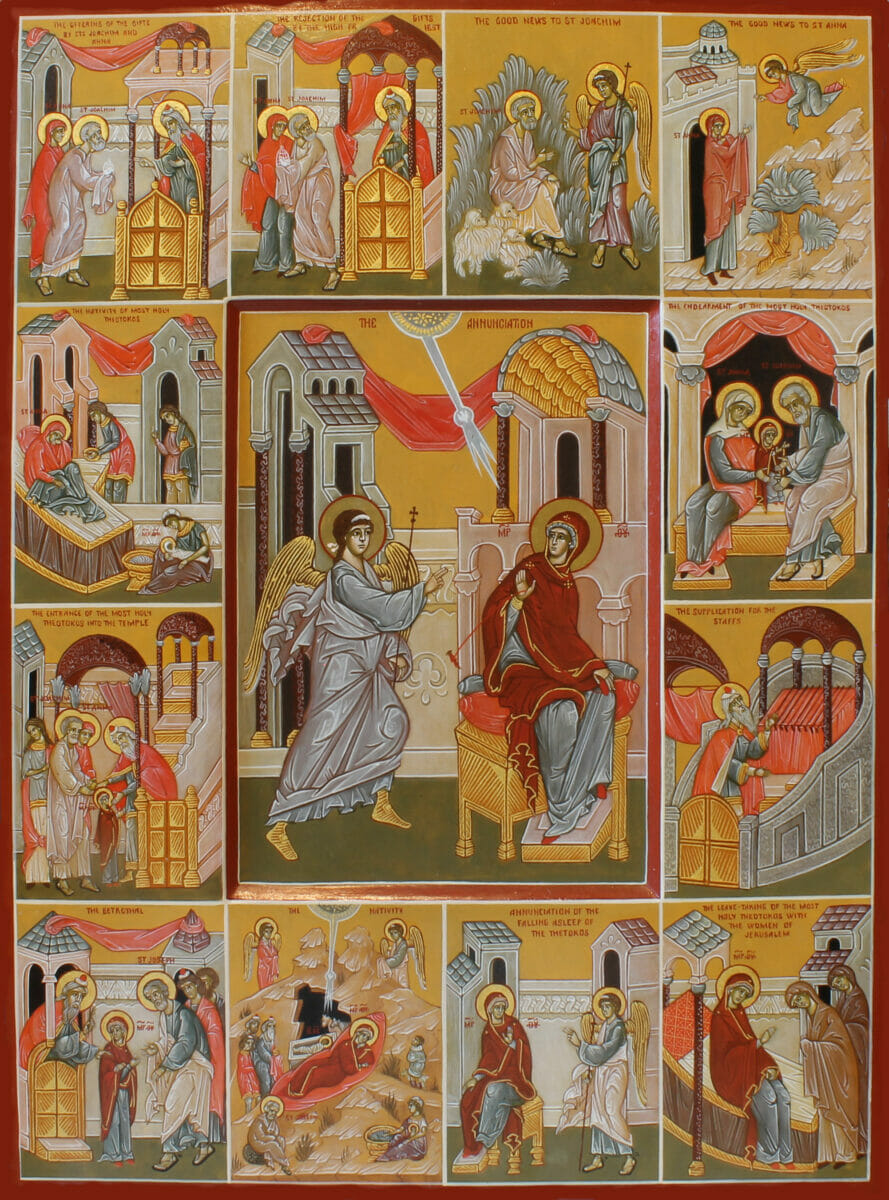
You are both, incredibly gifted, talented, and disciplined. If you ever decide to have a class, I am certain many budding iconographer would be interested in learning from you. Please put my name on the lust.
Thank you for this interview with Anna. She is a masterful iconographer, and, always, always a humble person. I feel blessed to have known her mother, and I am also blessed to know her. Our Church in Bonita Springs, Florida has six of her icons, and we treasure them. This wonderful article is especially good because it highlights her talents in the photos.
Crisp, clean and stunning work! We’d love to learn from her hand!
God bless All ❤️❤️❤️
Mick
Modesty is a beautiful thing for an iconographer. Something you can’t hear in this interview is how in person, Anna’s quiet deliberate answers are always surrounded by a thoughtful silence (and a disarming sense of humor). She has awe for the work, understands it’s an enormous responsibility, and knows her role in it all. When Ksenia talked about the disposition of an iconographer, she repeated Luke 17:10 “…when you have done all the things commanded of you, say, we are unprofitable servants; we have done that which was our duty to do”. It’s not even modesty, it’s just honesty.
I enjoyed reading this interview transcript. Thank you so much!
Excellent interview. The icons bear out what her words are saying. They show her mastery of the process and the elements of the icon, without being flowery. It seems like she lets the saints do the talking, not her painting.